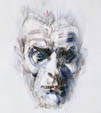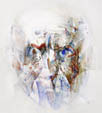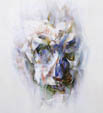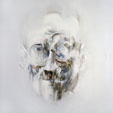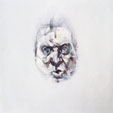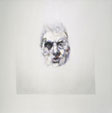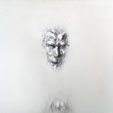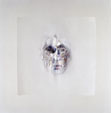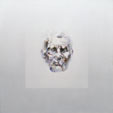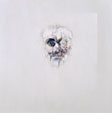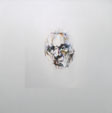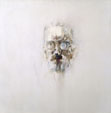Embarks on the Portrait Heads series (1975-2007), the fifth distinctive period in the artist's work.Assessing
the artist prior to the advent of his celebrated portrait heads of literary
and artistic figures, Dorothy Walker writes in Hibernia: 'He emerges
with a form of art which is, I think, unique in the world of art at present.
While classical in terms of brush-stroke oil painting, it is beyond the avant-garde in terms of social concern, and is of the immense over-riding
concern for the anguish of the individual'. The motivation comes about
through a commission by the Swedish gallery-owner Per-Olov Borjesson to
assemble a portfolio of thirty three aquatints of Nobel prizewinners by
international artists. This commission
was the catalyst which inspired the artist to paint a long series of evocative
heads of literary figures and fellow artists, including
W.B. Yeats, James Joyce and his friends Samuel Beckett, Francis Bacon,
Seamus Heaney and Bono. Le Brocquy remarks: 'From among the several Irish Nobel prizewinners
at that date - Beckett had not yet received his award - I chose Yeats as
my subject, having known him when I was a boy and because of his vast and
mysterious personality. I made a number of studies for my final aquatint,
and was struck by their diversity. It was then I realised that a portrait
can no longer be the stable, pillared entity of Renaissance vision - that
the portrait in our time can have no visual finality'. John Montague observes:
'So the le Brocquy who rejected an early career as a portrait painter finds
himself, as all artists do, back where he started, but with an added richness'.
According to Alistair Smith: 'Le Brocquy found himself painting study after
study in watercolour, charchoal and oil, as a form of preparation for the
final print. That aquatint, concluded in the suggestive, vestigial manner
of some of the earlier Heads, showed the poet full-face, hovering
within the white "matrix" of space and time ... The etching bears
the title Study towards an Image of WB Yeats, as did many of the
other pictures of Yeats which le Brocquy created in preparation for this
image, and which he was to continue to create after its completion' The
artist explains: 'In order to produce a human image which has some kind
of contemporary relevance, you have to recognise that certain factors which
have arisen in the last hundred years have revolutionised the way we look
at things. Because of photography and the cinema on the one hand, and psychology
on the other, we can no longer regard a human being as a static entity,
subject to merely biological change ... Replacing the single definitive
image by a series¯ of inconclusive images has, therefore, perhaps something
to do with contemporary vision, perceiving the image as a variable conception
rather than a definitive manifestation in the Renaissance sense ... Repetition,
on the other hand, implies not linear but circular thought, a merry-go-round
interpretation of reality, another form of completion, another whole, which
can be entered or left at any point. This latter counter-Renaissance tendency
is, curiously enough, already evident here and there within our Irish tradition,
from the Books of Kells and Lindisfarne to Finnegans Wake.' ...
COLM TOIBIN. A PORTRAIT OF THE ARTIST AS AN ALCHEMIST | LOUIS LE BROCQUY. THE HUMAN HEAD. NOTES ON PAINTING AND AWARENESS


|



